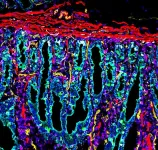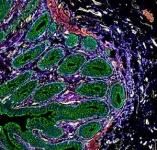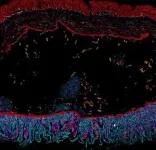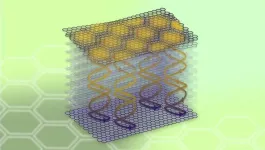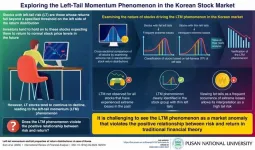(Press-News.org) When you think about your ideal neighborhood, perhaps you think of tree-lined streets or a close-knit community of people who help each other. You probably don’t think about your digestive system.
But maybe you should. According to a team of scientists led by researchers at Stanford Medicine, there are indeed “neighborhoods” of different cell types cooperating to digest your food and protect you from infection, among other things — and a new, ultra-high-resolution map of these neighborhoods proves your intestine is both functionally impressive and visually striking.
Just like human neighborhoods, which have common elements such as streets, restaurants and houses in varying numbers, cellular neighborhoods are made up of different quantities of cell types with specific functions. By combining several new imaging and sequencing technologies, the researchers were able to map these neighborhoods down to the level of individual cells.
“This is the first time anyone has made a spatial map of the intestine at the single-cell level,” said Michael Snyder, PhD, professor and chair of genetics and co-senior author of the research, published July 19 in Nature. “It was a bit like exploring a new planet, in that we didn’t know exactly what cell types we would find or how they would be organized.”
Mapping the gut
Researchers from multiple laboratories, at Stanford Medicine and other institutions, participated in the new mapping effort, part of the Human BioMolecular Atlas Program founded by the National Institutes of Health. Scientists in the program aim to create a comprehensive cellular map of the human body.
To map the gut, scientists examined eight regions of the small and large intestine from nine deceased donors. Using a technology called co-detection by indexing, or CODEX, which involves staining and washing the tissue repeatedly with fluorescent antibodies (substances that bind certain proteins and enable imaging), the researchers identified 20 distinct cellular neighborhoods based on the relative abundance of each cell type. Additional molecular analysis of RNA and chromosomal material from some of the samples provided an even greater level of detail within each cell type.
“Our maps are intended to be a reference for a healthy intestine, with which we can compare everything from irritable bowel disease to early-stage colon cancer,” said Snyder, the Stanford W. Ascherman, MD, FACS Professor in Genetics. “This will be foundational for our understanding of all kinds of digestive diseases.”
Neighborhoods of specialized cells
Roughly 20 feet long, the intestine absorbs nutrients from food and protects the body from invading microbes, while also maintaining a healthy balance of the beneficial bacteria that aid digestion.
To perform these tasks, the intestine employs a variety of cell types, including epithelial cells that make up the intestinal lining, connective tissue cells, nerve cells and immune cells. With the new maps, scientists were able to pinpoint where each cell type is located and which other cells they associate with.
“Looking at the presence or absence of a single cell doesn’t tell you much,” said Garry Nolan, PhD, the Rachford and Carlota A. Harris Professor and a professor of pathology, who led the research along with Snyder, the director of the Center for Genomics and Personalized Medicine, and William Greenleaf, PhD, professor of genetics. “It’s how cells are grouped together that defines their functionality.”
The researchers also wanted to see how the organization of healthy tissue changed throughout the digestive tract, from closer to the stomach to closer to the rectum. “What’s normal in one region might be a sign of disease in another,” said John Hickey, PhD, postdoctoral scholar in microbiology and immunology, and first author on the paper.
Some neighborhoods, such as the one dominated by smooth muscle cells (which control involuntary movements) became more common toward the end of the colon, while other neighborhoods composed primarily of immune cells became less common.
Associations with BMI and hypertension
In addition to creating a reference for healthy tissue, the new maps revealed some interesting clinical connections. For instance, the researchers found that donors with higher body mass index had a greatly increased number of M1 macrophages, a type of immune cell associated with inflammation.
“People who have a higher body mass index, especially above certain levels, are known to have higher risk for gastrointestinal disease,” Hickey said. “Many of those diseases are associated with chronic inflammation. Even though these donors didn’t have a history of GI disease, the increase in macrophages could be an indicator of a pre-disease process.”
Donors with a history of hypertension also had fewer immune cells of a different type, called CD8 T cells, which play a role in seeking out and destroying possible cancer cells. With the spatial map, the researchers were able to see that the CD8 T cells were missing from one particular neighborhood within the epithelial cells lining the intestine.
“This was an unexpected but important result,” Hickey said, “because we know the immune system plays a role in preventing cancer by pruning out malignant cells. If you have fewer CD8 T cells, you might have a higher risk of cancer.” Indeed, research has shown that patients with hypertension are more likely to develop colorectal cancer.
Future directions
In this study, all nine samples came from adult donors, and the majority were white and male. “One of our biggest next steps is to increase the diversity of the samples,” Snyder said. “Our goal is to get a much more comprehensive set of individuals, including multiple ethnic backgrounds and age groups.”
The scientists also hope to map the intestine in three dimensions, which will help them better visualize the networks of nerves and blood vessels in the healthy intestine.
“You can’t understand dysfunction until you understand what’s normal,” Nolan said.
END
It’s a beautiful day in the intestinal neighborhood
2023-07-19
ELSE PRESS RELEASES FROM THIS DATE:
UTHealth Houston study on seasonality of teen suicidality in JAMA Network Open
2023-07-19
The incidences of teen suicidality including self-harm, suicidal ideation, and suicide attempts increased nationally between 2016 and 2021; were at seasonal high peaks in April and October; and were at their lowest when schools were shut down during the COVID-19 pandemic, according to research at UTHealth Houston.
The study was published this month in JAMA Network Open. It was authored by Youngran Kim, PhD, assistant professor in the Department of Management, Policy, and Community Health at UTHealth Houston School of Public Health; Scott D. Lane, PhD, professor and vice chair for research in the Louis A. Faillace, MD, Department of Psychiatry and Behavioral ...
NASA funds 3 citizen science projects to study 2024 U.S. solar eclipse
2023-07-19
NASA has awarded funding for three science teams to conduct citizen science investigations as a total solar eclipse sweeps across North America on April 8, 2024. In these experiments, volunteers will help study the Sun and its ethereal outer atmosphere, called the corona, which is revealed when the Moon completely covers the Sun’s bright disk.
“During next year’s total eclipse, hundreds of volunteers will capture images of the Sun and its corona to help answer real science question about our star and how it affects us,” said program scientist and eclipse lead at NASA Headquarters, ...
Association between markers of structural racism and mass shooting events in major US cities
2023-07-19
About The Study: This study found that major U.S. cities with higher populations of Black individuals are more likely to be affected by mass shooting events, suggesting that structural racism may have a role in their incidence. Public health initiatives aiming to prevent mass shooting events should target factors associated with structural racism to address gun violence.
Authors: Michael Ghio, M.D., of Tulane University in New Orleans, is the corresponding author.
To access the embargoed study: Visit our For The Media website at this link https://media.jamanetwork.com/
(doi:10.1001/jamasurg.2023.2846)
Editor’s ...
Trends, seasonality of emergency department visits, hospitalizations for suicidality among children and adolescents
2023-07-19
About The Study: The findings of this study of 73,000 emergency department visits and hospitalizations for suicidality indicated the presence of seasonal patterns and an observed unexpected decrease in suicidality among children and adolescents after COVID-19–related school closures in March 2020, which suggest a potential association between suicidality and the school calendar.
Authors: Scott D. Lane, Ph.D., of the University of Texas Health Science Center at Houston, is the corresponding author.
To access the embargoed study: Visit ...
Two-faced star exposed
2023-07-19
In a first for white dwarfs, the burnt-out cores of dead stars, astronomers have discovered that at least one member of this cosmic family is two faced. One side of the white dwarf is composed of hydrogen, while the other is made up of helium.
“The surface of the white dwarf completely changes from one side to the other,” says Ilaria Caiazzo, a postdoctoral scholar at Caltech who leads a new study on the findings in the journal Nature. “When I show the observations to people, they are blown away.”
White dwarfs are the scalding remains of stars that were once like our sun. As the ...
Researchers put a new twist on graphite
2023-07-19
FROM: James Urton
University of Washington
206-543-2580
jurton@uw.edu
(Note: researcher contact information at the end)
Embargoed by Nature
For public release at 11 a.m. Eastern Time (8 a.m. Pacific Time; 4 p.m. British Summer Time) on Wednesday, July 19, 2023
Researchers put a new twist on graphite
For decades, scientists have been probing the potential of two-dimensional materials to transform our world. 2D materials are only a single layer of atoms thick. Within them, subatomic particles like electrons can only move in two dimensions. This simple restriction can trigger unusual electron behavior, ...
Understanding the many different ways animals are evolving in response to fire could help conservation efforts
2023-07-19
In our modern era of larger, more destructive, and longer-lasting fires—called the Pyrocene—plants and animals are evolving quickly to survive. By synthesizing the wide body of research about rapid animal evolution in response to fire in a review publishing in Trends in Ecology & Evolution on July 19, a multidisciplinary team of ecology experts hopes to leverage what we already know to help foster evolution-informed conservation plans. In this way, they suggest, we can try to harness the ways in which fire impacts animals to protect vulnerable species—working with evolution instead of against it.
In response to climate change and changes in land use, ...
Astronomers find new type of stellar object
2023-07-19
An international team led by astronomers from the Curtin University node of the International Centre for Radio Astronomy Research (ICRAR) has discovered a new type of stellar object that challenges our understanding of the physics of neutron stars.
The object could be an ultra-long period magnetar, a rare type of star with extremely strong magnetic fields that can produce powerful bursts of energy.
Until recently, all known magnetars released energy at intervals ranging from a few seconds to a few minutes. The newly discovered object emits radio waves every 22 minutes, making it the longest period magnetar ever detected.
The research was published ...
PNU researcher investigates left-tail momentum in the Korean stock market
2023-07-19
Left-tail risk (LT) stocks are those whose returns fall into the extreme end on the left side of the return distribution. In the hopes of mean-reverting to the normal price, investors usually hold on to these stocks. However, contrary to mean-reverting expectations, these stocks that have experienced extreme losses and high tail risks in the past tend to continue declining in the future, resulting in financial losses. This phenomenon, referred to as left-tail momentum (LTM), appears to challenge the traditional notion of a positive relationship between risk and return.
To investigate this market anomaly, a team of researchers, led by Prof. Eom from the School of Business at Pusan National ...
The puzzle of the galaxy with no dark matter
2023-07-19
A team of scientists, led by the researcher at the IAC and the University of La Laguna (ULL) Sebastién Comerón, has found that the galaxy NGC 1277 does not contain dark matter.This is the first time that a massive galaxy (it has a mass several times that of the Milky Way) does not show evidence for this invisible component of the universe. “This result does not fit in with the currently accepted cosmological models, which include dark matter” explains Comerón.
In the current standard model cosmology massive galaxies contain substantial quantities of dark matter, a type of matter which does not interact in the same ...
